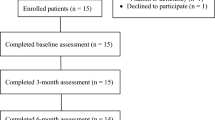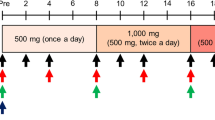Abstract
Bryostatin 1, a novel antineoplastic agent and protein kinase C (PKC) activator, has been found to induce myalgia (muscle pain) 48 h after administration in clinical trials. This is the dose-limiting toxicity and has restricted the duration of therapy in phase I trials. To investigate the mechanisms and try to increase toleration of the drug, we studied calf muscle metabolism of 14 patients at rest and during exercise and subsequent recovery using 31P magnetic resonance spectroscopy (MRS) before and 4 h, 48-72 h and 1-2 weeks following bryostatin therapy. In resting muscle there was a significant (P < 0.001) increase in the phosphodiester/adenosine 5'-triphosphate (PDE/ATP) ratio 48 h post bryostatin and in patients with myalgia compared with pre-bryostatin control studies. Following exercise, patients with myalgia showed significantly slower phosphocreatine (PCr) and ADP recovery half-time (P < or = 0.05) suggesting impaired mitochondrial (oxidative) energy production, possibly due to a direct effect on the mitochondria or secondary to reduced blood flow. The apparent proton efflux rate following exercise was significantly reduced 4 h after bryostatin (P < or = 0.05), suggesting reduced blood flow. The rate of post-exercise reoxygenation was studied in four patients by near-infrared spectroscopy 4 h post bryostatin. In three of these the rate was reduced, consistent with reduced muscle blood flow. Bryostatin 1 appeared to cause a long-lasting impairment of oxidative metabolism and proton washout from muscle, consistent with a vasoconstrictive action. Thus these studies provide evidence for two mechanisms of the dose-limiting toxicity for bryostatin. Prospective studies on the use of vasodilators to improve the tolerance of the drug should be carried out.
This is a preview of subscription content, access via your institution
Access options
Subscribe to this journal
Receive 24 print issues and online access
$259.00 per year
only $10.79 per issue
Buy this article
- Purchase on Springer Link
- Instant access to full article PDF
Prices may be subject to local taxes which are calculated during checkout
Similar content being viewed by others
Author information
Authors and Affiliations
Rights and permissions
About this article
Cite this article
Hickman, P., Kemp, G., Thompson, C. et al. Bryostatin 1, a novel antineoplastic agent and protein kinase C activator, induces human myalgia and muscle metabolic defects: a 31P magnetic resonance spectroscopic study. Br J Cancer 72, 998–1003 (1995). https://doi.org/10.1038/bjc.1995.449
Issue Date:
DOI: https://doi.org/10.1038/bjc.1995.449
This article is cited by
-
Phase II trial of bryostatin-1 in combination with cisplatin in patients with recurrent or persistent epithelial ovarian cancer: a California cancer consortium study
Investigational New Drugs (2012)
-
Drug development from marine natural products
Nature Reviews Drug Discovery (2009)
-
Phase I study of bryostatin 1, a protein kinase C modulator, preceding cisplatin in patients with refractory non-hematologic tumors
Cancer Chemotherapy and Pharmacology (2009)
-
Phase II trial of sequential paclitaxel and 1 h infusion of bryostatin-1 in patients with advanced esophageal cancer
Cancer Chemotherapy and Pharmacology (2008)



